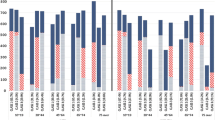Abstract
By studying time allocation, a factor implicitly linked to health by structuring individuals’ physical exercise, leisure, sleep, and access to care, we can better understand behavioral mechanisms to improve health in minority populations. We piloted the time diary method in a Honduran immigrant community to assess time spent in personal and interpersonal responsibilities, and we examined how these patterns varied by gender. In the context of participatory ethnography, 34 urban Honduran immigrants were recruited and followed over 7 days. Respondents reported activities by 30-min periods for seven 24-h days. Observed respondent-level reliability exceeded 0.7 for time spent in commuting, care work, family responsibility, and individual leisure, showing better results than 3- or 10-day tracking schemes. Gender differences in time allocation patterns were also observed. We argue that understanding time use patterns will elucidate gendered disparities in health outcomes associated with physical mobility, and in access to health care.

Similar content being viewed by others
References
Dufour DL, Reina JC, Spurr GB. Physical activity of poor urban women in Cali, Colombia: a comparison of working and not working women. Am J Hum Biol 2003;15:490–7.
Wood FG. Leisure time activity of Mexican Americans with diabetes. J Adv Nurs 2004;45:190–6.
Bratteby LE, Sandhagen B, Lotborn M, Samuelson G. Daily energy expenditure and physical activity assessed by an activity diary in 374 randomly selected 15-year-old adolescents. Eur J Clin Nutr 1997;51:592–600.
Marquez DX, McAuley E. Gender and acculturation influences on physical activity in Latino adults. Ann Behav Med 2006;31:138–44.
Hale L. Who has time to sleep? J Public Health (Oxf) 2005;27:205–11.
Heymann J. The widening gap: why America’s working families are in jeapardy and what can be done about it. New York: Basic; 2000.
Robinson J, Godbey G. Time for life: the surprising ways that Americans use their time. University Park: The Pennsylvania State University; 1997.
Schor J. The overworked American: the unexpected decline of leisure. New York: Basic; 1992.
Hochschild A. The second shift. Working parents and the revolution at home. New York: Viking; 1989.
Creswell J. Research design. Qualitative, quantitative, mixed methods approaches. Thousand Oaks: Sage; 2003.
Parrado E. Participatory survey research: integrating community collaboration and quantitative methods for the study of gender and HIV risks among Hispanic migrants. Sociol Methods Res 2005;34:204–39.
Charmaz K. Grounded theory: objectivist, constructivist methods. Thousand Oaks: Sage; 2000.
Kawachi I, Kennedy BP. The relationship of income inequality to mortality: does the choice of indicator matter? Soc Sci Med 1997;45:1121–7.
Elliott LJ, Blanchard JF, Beaudoin CM, et al. Geographical variations in the epidemiology of bacterial sexually transmitted infections in Manitoba, Canada. Sex Transm Infect 2002;78(Suppl 1):i139–44.
Schmalzbauer L. Striving and surviving: a daily life analysis of Honduran transnational families. New York: Routledge; 2005.
Higgins PG, Learn CD. Health practices of adult Hispanic women. J Adv Nurs 1999;29:1105–12.
Maly RC, Umezawa Y, Ratliff CT, Leake B. Racial/ethnic group differences in treatment decision-making and treatment received among older breast carcinoma patients. Cancer 2006;106:957–65.
Evenson KR, Sarmiento OL, Ayala GX. Acculturation and physical activity among North Carolina Latina immigrants. Soc Sci Med 2004;59:2509–22.
Scarinci IC, Beech BM, Kovach KW, Bailey TL. An examination of sociocultural factors associated with cervical cancer screening among low-income Latina immigrants of reproductive age. J Immigr Health 2003;5:119–28.
Derose KP. Networks of care: how Latina immigrants find their way to and through a county hospital. J Immigr Health 2000;2:79–87.
Dodson L, Schmalzbauer L. Poor mothers and habits of hiding: participatory methods in family research. J Marriage Fam 2005;67:949–59.
Author information
Authors and Affiliations
Corresponding author
Rights and permissions
About this article
Cite this article
Anastario, M., Schmalzbauer, L. Piloting the Time Diary Method Among Honduran Immigrants: Gendered Time Use. J Immigrant Minority Health 10, 437–443 (2008). https://doi.org/10.1007/s10903-007-9109-z
Published:
Issue Date:
DOI: https://doi.org/10.1007/s10903-007-9109-z



